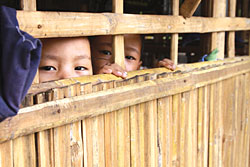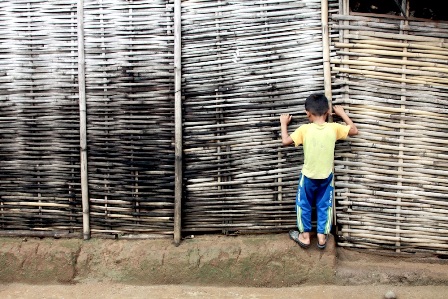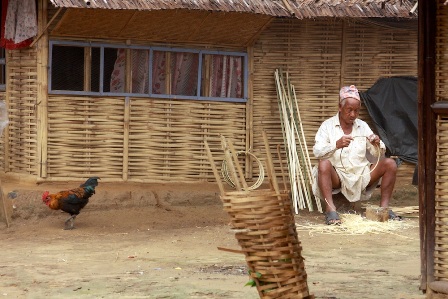 PICS: MARCUS BENIGNO LEAVING THE PAST BEHIND: Refugee children peer through their bamboo home in Beldangi, while their family awaits emigration. |
The government and the UN High Commissioner for Refugees (UNHCR) are closing and consolidating the camps as some of the remaining 63,000 refugees prepare to leave. Locals who depend on the camps for business and jobs now have to seek refuge elsewhere. Nearly 700 families were relocated to Beldangi and Sanischare from Goldhap in eastern Jhapa in June. Goldhap, the fifth and smallest of the camps which housed 4,600 refugees since 1990, is now a vacant lot.
 The Goldhap camp is now a vacant lot while the street outside Beldangi camp is full of money transfer offices.
|
For seven years Upreti and her family have lived off the main road leading into the Goldhap entrance. "When the camp was here, there was a market and it was good for us," Upreti told Nepali Times. "They helped us when we had floods and we helped them when they had fires."
A fire in March razed nearly all the refugee huts in Goldhap. Refugee Chiranjibi Rai says when the fire trucks finally came their tanks were empty. "Luckily, the locals and the Nepal Army on guard helped," he said.
 Lilamaya Upreti and her daughter-in-law Sumitra are worried about the loss of business after the refugees leave. |
 A local mobile charging shop will lose customers when the camp closes. |
But when the final refugees left Goldhap, so did the markets and public transport. Of the remaining four camps, two others are scheduled to close: Timai by the end of the year and Khudunabari in 2012.
"We are here to take care of refugees, but the government and other UN agencies are planning community development activities around the camps benefiting the remaining refugees and the host community," said Stephane Jaquemet, UNHCR country representative in Kathmandu.
As refugees leave and locals wait, there is doubt that the government and international donors will respond. Said Upreti: "We're waiting but always only the local leaders benefit. For us common people, we get nothing."
 A refugee child peers into a hut that runs a tv on bootleg electricity.
|
Read also:
Those who want to stay, GOPAL GARTAULA in JHAPA
Bhampa Rai was a royal physician before being driven out of Bhutan. Unlike most refugees, he doesn't want to be resettled in America or Europe.




